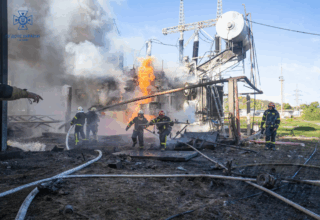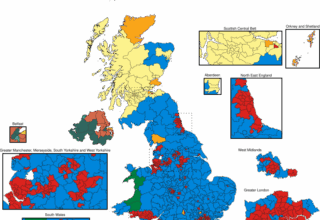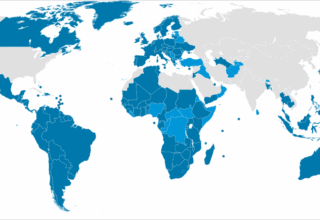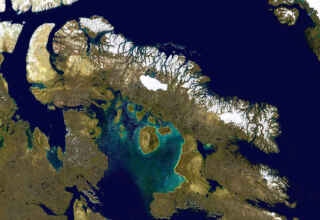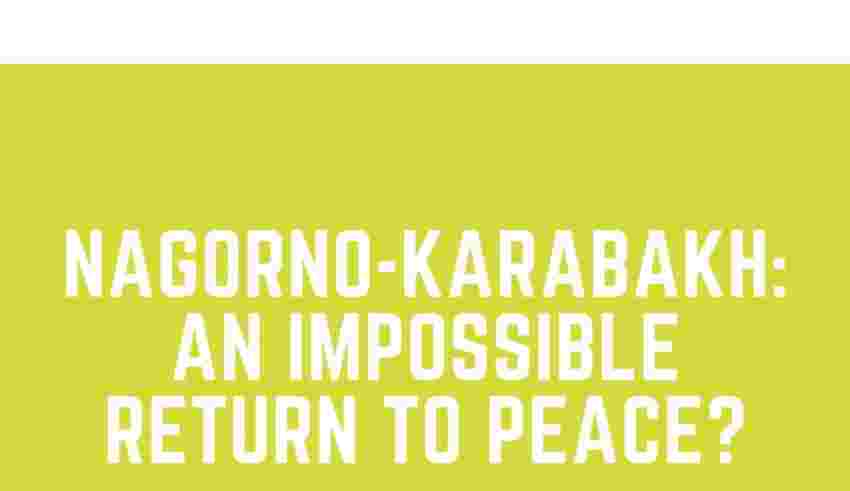
Since September 2020, a war has been raging between Azerbaijan and Armenia over power in the Nagorno-Karabakh area resulting in more than 6,000 deaths. The Karabakh region is disputed on mainly historical grounds by both Azeris and Armenians. The Azeris claim that the region has always been under Azeri rule in known history; by contrast the Armenians advance the claim that Karabakh was originally an Armenian site of residence and that Azeri rule was illegitimate. The disputed and confusing history of the Karabakh region can be seen in its very name. Karabakh is actually an amalgamation of Turkish and Persian. ‘Kara’ means Black in Turkish, and ‘baõ’ means garden in Persian as well as vine in Turkish. The contemporary ending ‘bakh’ stems from the russification of the word ‘bag’. The word ‘Nagorno’ simply means mountainous in Russian. Thus in the name of the region, three different languages can be found, in fact the languages of the three powers that have dominated the history of the region. The region is termed Artsakh in Armenian, and Yuqarí or Daglíq Qarabag in Azeri. (Astourian, 1994).
The conflict has its origins in the early 20th century, though the present conflict began in 1988, when the Karabakh Armenians demanded that Karabakh be transferred from Soviet Azerbaijan to Soviet Armenia. The conflict escalated into a full-scale war in the early 1990s. Some analysts have suggested that this local conflict gravely weakened the Soviet Union and thus directly contributed to the end of the Cold War. The Nagorno-Karabakh conflict has also been depicted as part of a general wave of ethnic violence that arose once the Cold War was largely over (Melander, 2001).
This conflict, which has deep historical and cultural roots, has repercussions to this day. There have been various peace proposals by the regional and international mediation for halting the fighting and ensuring the peaceful resolution of the conflict between two South Caucasian countries. These include the peace initiative of Kazakhstan and Russia, the mediation efforts of Iran and Turkey, the resolutions of the United Nation Security Council, and the peace proposals of the OSCE Minsk Group (Mahmudlu & Abilov, 2018). Armenia and Azerbaijan have no diplomatic ties and continue to view each other as archenemies. Even after the ceasefire of the recent clashes in 2020, tensions do not seem to have subsided, and so-called diplomatic incidents are multiplying, leaving the door open for new overt conflicts to arise. This article will therefore analyse the origins of this conflict, highlighting the major implications and issues at stake, before proposing a more recent study and the transcription of previous historical observations applied to the current context.
The ethnic dimension and the Russia and Turkey implication
Many analysts claim that the Nagorno Karabakh conflict in the 90s caused the collapse of the Soviet Union in that it was the first overt ethnic identity-based crisis within the Soviet Union after World War II. This crisis showed that the Soviet nationalities policies were not sound enough, and not equally effective throughout the country (Askerov, 2020). In addition, Russia’s need for oil and the desire to move into these hot zones is the reason why this Nagorno-Karabakh issue remains an issue that continues to have an impact today. Although the Nagorno-Karabakh region has been within the territory of Azerbaijan for many years, Russia has taken control of this region and Russia has given control of the Nagorno-Karabakh region to the Armenians (DİYARBAKIRLIOĞLU, 2020). As a history, Karabakh is a region within the borders of the Caucasus Turkish culture. The Karabakh region has been a region consisting of the unification of Turkish and Iranian ethnicities and has been a region of Turkish origins for many years. But as a result of Russia’s incitement to the Armenians, the Azeri Turks had migrated to these regions. The policies of Armenians in the Nagorno-Karabakh region had carried out and aimed to increase the Armenian population there (DİYARBAKIRLIOĞLU, ibid).
This ethnic dimension is also linked to a religious issue. Indeed, Azerbaijan is home to a large Muslim population, yet the inhabitants of the mountainous areas are not: i.e. the one in Nagorno-Karabakh. As for the Armenian origins of the territory, they could not be found, however the lands were converted to Christianity later on, under the control of Armenian policies.
After the Ottoman Empire and Iran’s loss of power, Russia has been the major actor in the South Caucasus since the 18th century. With the collapse of the Soviet Union, Russia lost both its economic and political power in the region. However, after Vladimir Putin came to power, Russia regained its centrist policies and its willingness to participate in the international “great game” in order to occupy a great power role in the region. Since 2008, the Russian president has proved this through the invasion of Georgia and the recognition of South Ossetia and Abkhazia as independent states. Officially, this is a strategy to counter NATO enlargement, perceived as a threat by Putin (Değirmencioğlu, 2019). Russia and Armenia are close military allies and there is a Russian military base in Armenia (HELVACIKÖYLÜ, 2021). But since the conflict took place on Azerbaijani territory, Russia has stepped back to maintain diplomatic relations with both countries. It was also a way for Russia to show its opposition to the then new pro-European Armenian Prime Minister who had tried to remove all pro-Russian government members, Yerevan. Russia is showing the new Prime Minister that leaving his circle of friends would be bad for his country. The agreement stated that Armenia should leave Kalbajar district until November 25, 2020 and Lachin district until December 1, 2020 appears to be a victory for Russia. Indeed, there will be 1,960 Russian military personnel and several military vehicles and equipment. In addition to this, a transport corridor will be established between Azerbaijan and Nakchivan Autonomous Republic, which will allow both the citizens and cargo transit to Armenian territory, knowing that this road was closed after the first Karabakh War in the 1990s (Clayton, 2020). Russia has therefore played a mediating role throughout this conflict in order to defend its own interests. Therefore, it can be said that Russia was not much willing to resolve this conflict since the ambiguity made both sides dependent on Moscow. Furthermore, Russia has always tried to keep a balance in the military relations with both sides; selling both Azerbaijan and Armenia military equipments and guns, which created economic gains for Russia as well. It should be noted that the Nagorno-Karabakh conflict could also have repercussions on the ethnic communities within Russia itself, something that Russia is keen to avoid.
Ethnic and historical ties with the people of South Caucasus, has led Turkey to act with emphasis for the resolution of the conflicts within the region. Turkey has always been a major Azerbaijan’ ally, as economically as diplomatically. The region is also of national security interest to Turkey as it borders the South Caucasus. The country was also used by Western powers, led by the EU and the US, to counter Russian ambitions in the region. Therefore, pipeline (energy) projects such as the Baku-Tbilisi-Ceyhan (BTC), the Baku-Tbilisi-Erzurum (BTE) and the Trans-Anatolian Pipeline (TANAP) were designed for increasing economic wealth as a will from Ankara to end the dependency between these states from Russia. The establishment of regional cooperation has the same function of opposing Russian macrocephaly. In this respect, the Black Sea Economic Cooperation (BSEC) and the enlargement of Economic Cooperation Organization (ECO) also play crucial roles (HELVACIKÖYLÜ, ibid). Furthermore, Armenia’s claims on the lands of Turkey as well as Azerbaijan’s create a security threat for Turkey. It is also part of Turkey’s wider ambitions to pacify its relations with Armenia, the past having a very heavy weight in their exchanges. However, despite the balanced relations of Russia with Azerbaijan and Armenia, Turkey has always showed its support to Azerbaijan explicitly. Moreover, Turkey played an important role for renewing Azerbaijan’s military equipments and increasing its military capacity, which was a crucial factor in Baku’s military success in the latest war (BBC, 2020). Turkey, while not directly involved in the conflict, does play a major role in the peacekeeping missions.
Ethnic diversity thus contributes to the rise in tension in the region, which has been historically entrenched for over a century. The Soviet past of the region has an extremely important weight which influences external actions opposed by Turkey, contributing to the concentration of many security issues in a limited space.
Geopolitical view of the conflict
The Nagorno-Karabakh conflict has not only been a bilateral conflict between Azerbaijan and Armenia, it has also drew the attention of regional and extra-regional powers since Nagorno-Karabakh is bordered with oil-rich and natural-blessed countries of the world. It also opened the door for foreign intervention, subversive activities, arms race and backdoor diplomacy for the vested interests of regional powers. Nagorno-Karabakh Republic which is commonly known as Artsakh is currently under the control of ethnic Armenians, however, it officially and legally is the part and parcel of Azerbaijan (Rasizade, 2011). However, countries like Greece, Cyprus, France, Russia, Iran and US supported the cause of Armenian in international forums. There is no doubt that this international support is only intended to strengthen a bid for the region’s rich oil reserves. On the other hand, Pakistan and Turkey have announced their diplomatic support in favor of Azerbaijan explicitly during the war-time phases between Azerbaijan and Armenia on Nagorno-Karabakh (Khan & Syed, 2021). Saudi Arabia, Palestine, Israel, Kosovo, Serbia, Ukraine, Moldova, Uzbekistan along with Organization of Islamic Cooperation (OIC) have also been found in supporting Azeri stance in the region. The Turkish, Iranian, US and Russian military, political and economic aids and cooperation to both sides of the conflict have never allowed Armenia and Azerbaijan to resolve the Nagorno-Karabakh conflict amicably and diplomatically (Jan et al., 2021). Russian economic and military aids to Armenia are perceived a regional threat to the national security of Azerbaijan (Cornell, 1999) whereas the same alliance and nature of cooperation with Azerbaijan would become a threat to the national security of Armenia. This argument supports the view that the regional powers at work do not want, and have no interest in, a diplomatic resolution of the conflict.
Azerbaijan strongly relies on its natural gas and oil to strengthen its economy, politics and military to regain the occupied territory of Nagorno-Karabakh. Unfortunately, Armenia acts is the major obstacle for Azeri regime in planning to export and ship the oil and gas to European Nations via Turkey because Armenia falls on the Western border of Azerbaijan which disconnects Azerbaijan with Europe (Jan, ibid). With the support of the US and the EU, Azerbaijan’s geo-economic and geo-strategic interest is much better than Armenia’s, especially as it is one of the best endowed republics in Eurasia in terms of oil and natural gas, which explains the European investment in this area. A gas pipeline is currently being prepared to link Baku to Italy. Armenia has to fortify its relations with Russia and Iran to encounter Azeri geo-political powers in the region (ibid). However, one should not lose sight of the importance of the Armenian lobby in the US Congress, which could very well influence US policies in the future. Turkish solidarity with Azerbaijan would continue at the cost of Armenia due to historical territorial differences with Armenia. Moreover, the Armenians do not only perceive Turkey as a national security threat for Armenia, they also view Turkey as a genocidal Republic (Cornell, ibid). The Iranian and Russian political, economic and military support to Armenia against Azerbaijan can better jeopardize Azerbaijan since they are not only the regional powers, they also share direct borders with Azerbaijan, which is not the case of Turkey. Moreover, Azerbaijan is an oil-rich country, which Iran does not like, especially if it shares a border with it.
This conflict has thus geo-political importance for the regional and international powers which explains both the fact that this conflict is still not fully resolved, but also the scale of the violence once clashes occur. Furthermore, the conflict also involves the risk of 3rd World War as both US and Russia are directly positioned on two different sides. The foreign involvement in Nagorno-Karabakh conflict is intended to entertain the regional policies of regional powers which have given birth to human crisis.
The conflict in International law
As we have seen previously, on 27 September 2020, a conflict in Nagorno-Karabakh erupted. For two long months, heavy artillery and drones were deployed in bloody clashes resulting in numerous civilian and military casualties on both sides (BBC, 2020). In spite of the conflict’s intensity and inter-State dimension, very few States commented on the compatibility of the protagonists’ conduct with the international law on the use of force, the jus ad bellum (Ruys & Rodriguez Silvestre, 2021). It is obvious that this question can have more general aspects, applying for example to the situation known with the Palestinian lands occupied since 2004 by Israel. Thus, is the long-term occupation of a territory sufficient reason to justify defensive action to reclaim the land, and can the occupation therefore be considered a continuing attack by one state on another?
Since the 1994 ceasefire agreement, the position widely held by the international community has been that the Nagorno-Karabakh region is occupied by Armenia, as confirmed, for example, by the UN General Assembly and the European Court of Human Rights (ibid). In contemporary international law, the jus ad bellum and jus in bello, also referred to as international humanitarian law (IHL), are two independent and self-contained branches of international law (D’Alessandra & Heinsch, 2018). In classical international law, their separation was characterized as a dichotomy between the norms operating in times of peace and those applicable in times of war (Milanovic & Hadzi-Vidanovic, 2013). An important implication arising from the foregoing reasoning is that States involved in hostilities need to circumscribe their military activities, throughout the entire conflict, to necessary and proportionate measures adopted in the context of self-defense. At the same time, they must observe the existing rules on methods and means of warfare and the law of occupation (Okimoto, 2011). In the specific context of belligerent occupation, the dual application of the jus ad bellum and IHL is particularly present throughout its entire duration (Giladi, 2012). In case of prolonged occupation, which is the type of situations which inform the current study, it has been suggested that occupation outlives the international armed conflict that originated it in the first place (Milanovic, ibid). The crucial point for present purposes is that the mere existence of an ongoing situation of prolonged belligerent occupation does not eclipse the need for a proper legal basis under the jus ad bellum when one of the States launches a new attack against the other. A State whose territory has been occupied without its consent may use force to recover it as long as its actions can be justified under the jus ad bellum, that is, if the military operation qualifies as a measure of self-defence both necessary and proportionate to the armed attack to which it is responding.
Is the recovery of occupied territory solely a matter for the domestic law of the (occupied) country or does it fall under international law? The jus ad bellum legal framework enshrined in the UN Charter, as well as in customary international law, has a manifest inter-State scope, as has been consistently upheld by the ICJ. Article 2(4) of the UN Charter prohibits explicitly the threat or use of force solely between States and, more specifically, in the exercise of their international relations. Similarly, Article 51 recognizes the right of self-defense in response to an armed attack against a member of the United Nations, thus confirming that States are the sole subjects of international law and, as such, are bound and protected by the prohibition of the use of force and, consequently, entitled to the right of self-defense as a temporary measure of self-help (Ruys & Silvestre, ibid). Conversely, the use of force carried out by a State within its territory in the exercise of its domestic jurisdiction does not fall under the scope of the prohibition of the use of force. There is therefore no need to justify internal territorial action under the jus ad bellum regime as this is a matter of state sovereignty, and it is the prerogative of the state to deploy its troops within its own borders. But military occupation is regarded as a textbook example of the use of force against the territorial integrity of a State and is listed as an act of aggression under Article 3(a) of the 1974 UN General Assembly Definition of Aggression (Benvenisti, 2009). Belligerent occupation in the legal sense is necessarily linked to the existence of an inter-State conflict between two or more States (Spoerri, 2014). Recovery of occupied land will therefore necessarily depend on Article 2(4) and will indeed have to be justified by evidence of self-defence under IHL. The situation in Nagorno-Karabakh is therefore a conflict between states, not a simple national operation to retrieve land from a non-governmental force or group from its own territory and must therefore comply with the rules of the Security Council.
With these two principles in mind, one can then ask whether Azerbaijan can indeed invoke the right of self-defence against Armenia to justify the resumption of the conflict. According to the arguments of the Azerbaijani government, the answer is yes, because similar to the approach of Egypt and Syria during the Yom Kippur War, Azerbaijan accused Armenia of having “launched another aggression against Azerbaijan, by intensively shelling the positions of [its] armed forces” on September 27, 2020 (Azerbaijan U.N. Letter, 2020). From this point of view, the Azeri operations were simply a response to Armenian aggression. Does this mean that the action is justified by the liberty to challenge the territorial status quo and pursue the recovery of its land through military means? No, because the principle of self-defence obeys to a logic of immediacy, which if not respected, takes away the right of the occupied state to use force. One of the Charter objectives that is pivotal in this context concerns the protection of States’ territorial integrity, which is expressly mentioned in Article 2(4), and, on a related note, the “suppression of aggression” in Article 1(1). While emphasizing the purpose of the United Nations is “to maintain international peace and security” and “save future generations from the scourge of war,” the Charter’s preamble also stresses the fundamental human rights of individual human beings—including, first and foremost, the right to life. In this sense, it protects the right to life and protects fundamental human rights (Ruys, ibid), knowing that the aggression of another State results, according to the Human Rights Committee, in “deprivation of life, violate ipso facto article 6 of the [International] Covenant [on Civil and Political Rights]”. In the end, in the context of occupation, the objective behind the prohibition of the use of force is better accomplished by protecting the territorial status quo instead of granting an open-ended right to self-defense with no time constraint (ibid).
Uneasy return to calm
After two months of military confrontations, the hostilities came to an end with the signing of a tripartite statement between Armenia, Azerbaijan, and the Russian Federation on the 9th of November 2020. However, calm does not seem to have quite returned to the region, reaching a new status of tensions threatening to erupt at any moment similar to that after the first war in the 1990s. According to Yerevan, the Azerbaijani military advanced up to 4 kilometers into the new border area as recently as mid-May (2021). In the process, it occupied more than a dozen heights near the Armenian villages of Kut and Verin Shorzha and began building fortifications. Both Armenian and Azerbaijani posts can be seen on the hills, sometimes with less than 15 meters (50 feet) between them (Gazazian, 2021). To take one example, the village of Kut has more Azeri soldiers than inhabitants, becoming a small fortress and driving the Armenians from their homes. The trilateral cease-fire agreement of November 9 planned to open up the roads to civilian traffic, but in reality it did not. Two roads connecting Gegharkunik with Kalbajar and further with Stepanakert in Nagorno-Karabakh are completely closed (ibid). We have previously explained how roads and the proximity of troops is a determining factor in the escalation of tensions that can lead to violence. This is an indication of the instability in the region. The closures are affecting the region’s economy, and without transports, the tourists stay home. This feeling is shared by many inhabitants, including shepherds who no longer take their sheep out to pastures for fear of becoming targets, and who do not see how the situation could not degenerate. The two sides often meet to trade and negotiate, but nothing ever goes according to plan, and fights become commonplace, with one Armenian soldier even losing his life in a brawl (ibid). Despite the extremely tense situation and the country’s commitments in the region, Russian troops are absent, preferring to position themselves in cities and airports, neglecting their duty to guard the border and peacekeeping role. Incidents are becoming commonplace between the two sides, while the situation does not seem to reach a state of calm.
Indeed, following the Armenian defeat and the redeployment of Azeri troops in the region, tensions never really subsided. For example, two Armenian workers were captured by Azerbaijani forces on 27 May. The Armenian government justifies itself by saying that these men were carrying out civil engineering work, while Azerbaijan retorts that these were operations to attack its territory and that tanks were positioned nearby, predicting an imminent offensive (Le Monde, 2021). Since the ceasefire, seven soldiers and 15 civilians have been killed by land mines and over a hundred have been wounded. On 4 June, two journalists, Sirac Abisov (state AzTV) and Maharram Ibrahimov (AzerTag), and a local official were killed by a land mine. Another four were wounded. Continued tensions, political instability in Armenia, and the danger of mines are preventing international organisations such as the UN from delivering humanitarian assistance to the region. Currently only the International Committee of the Red Cross is on the ground (Kuzio, 2021).
The military situation on the ground therefore remains extremely worrying, and one can only wonder whether a political changeover will change the situation. The election on Sunday in Armenia showed that nationalist fervour remains highly charged. The political class wants to keep Russian troops to maintain peace in the region. As their departure is initially planned for 2025, Armenian politicians do not see how peace could last after the departure of Russian troops who, however, as we have seen, appear to be rather disconnected from the real issues on the ground. For its part, Azerbaijan prefers the withdrawal of Russian troops on the scheduled date and their replacement by UN or OSCE peacekeepers. In other words, peace seems to be a relative concept in the region, and despite a peace treaty providing for peacekeeping actions, nothing has been done to ease tensions. It is therefore essential to strengthen the precarious peace that is currently in place and that threatens to break at any moment. There are two possibilities for doing so.
– First, to accept Russia’s place as a major international power mediating the conflict. The advantage is that the Russian soldiers already have knowledge of the issues and the terrain, and appear to be an objective external actor in dealing with this peace issue. Choosing this option would mean giving Russia a clear mandate for its long-term mission in the region, which is not the case today, as the ICG points out (ICG 2021). We can read that the “parties should build upon ad hoc contacts to create a regular channel for addressing urgent problems”. Indeed, Russian soldiers need to be in places of effective tension rather than playing a parade role at key locations. However, this solution raises a deleterious aspect, namely Armenia’s dependence on Russia. It is the mediator’s objectivity that is called into question here, as both countries were part of the former Soviet republic of which Putin is known to be nostalgic. This would increase Armenia’s dependence on Russia, creating the risk of future harmful interference and increasing the latter’s power in the region.
– A second option would be, far from favouring one side over the other by acceding to a request from Azerbaijan, to favour a totally neutral actor to ensure peace between the two countries. This solution would have the advantage of incorporating an objective international actor who would be able to enforce international law while encouraging humanitarian operations in the region to relieve the Red Cross. It would also thwart Russia’s plans to gain strength against NATO and would probably provide security in the longer term. Nevertheless, one should not lose sight of the importance of the terrain, which is very uneven in the region and requires soldiers trained in this type of operation. The effectiveness of such troops, such as peacekeepers, whose scope of action remains limited in Africa and is the most casualty-ridden army corps in the world, must also be qualified.
Bibliography
Askerov, A. 2020. The Nagorno Karabakh Conflict, the Beginning of the Soviet End. Post-Soviet Conflicts: The Thirty Years Crisis, chapter 3.
Astourian, H. 1994. “In Search of Their Forefathers: National Identity and the Historiography and Politics of Armenian and Azerbaijani Athnogeneses”, in Donald D. Schwartz and Razmik Panossian, Nationalism and History: The Politics of State-Building in Post-Soviet Armenia, Azerbaijan and Georgia, Toronto: University of Toronto Press.
Azerbaijan U.N. Letter dated Sept. 27, 2020 from the Permanent Rep. of Azerbaijan to the United Nations addressed to the U.N. Secretary-General, U.N. Doc. S/2020/948 (Sept. 28, 2020) [hereinafter Azerbaijan U.N. Letter dated Sept. 27, 2020]; Permanent Rep. of Armenia to the United Nations, Letter dated Sept. 28, 2020 from the Permanent Representative of Armenia to the United Nations addressed to the U.N. Secretary-General, U.N. Doc. S/2020/955.
BBC News. 2020 December 3. Nagorno-Karabakh Conflict Killed 5,000 Soldiers. Available at: https://www.bbc.com/news/world-europe-55174211
Benvenisti, E. 2009. Occupation, Belligerent, MAX PLANCK ENCYCLOPEDIA OF PUBLIC INTERNATIONAL LAW (updated May 2009).
Clayton, A. 2020. “The Nagorno-Karabakh Peace Deal: Reading Between the Lines”, Caspian Policy Center, 16.11.2020. Available at: https://www.caspianpolicy.org/the-nagorno-karabakh-peace-deal-reading-between-the-lines/
Cornell, S. E. (1999). The Nagorno-Karabakh Conflict: Uppsala Universitet.
D’Alessandra, F. & Heinsch, R. 2018. Rethinking the Relationship Between Jus inBello and Jus ad Bellum: A Dialogue Between Authors, in SEEKING ACCOUNTABILITY FOR THE UNLAWFUL USE OF FORCE 453, 490.
Değirmencioğlu, I. B. 2019. “Nagorno Karabakh Conflict and The Holistic Analysis of The Intractability”, Alternatif Politika, Vol.12, No: 2, p. 354.
DİYARBAKIRLIOĞLU, K. The Nagorno-Karabakh Conflict between Azerbaijan and Armenia from the Historical Perspective. International Journal of Social, Political and Economic Research, volume 7, Issue 2, 2020, 415-439.
Gazazyan, A. 2021 June 12. After Nagorno-Karabakh conflict, uneasy calm prevails at new border. Deutsche Welle. Available at: https://p.dw.com/p/3umIi
Giladi, R. 2012. The Jus ad Bellum/Jus in Bello Distinction and the Law of Occupation, 41 ISRAEL LAW REVIEW 246, 249.
HELVACIKÖYLÜ, G. 2021. The Role of Turkey and Russia on the Resolution of the Nagorno-Karabakh Conflict. UPA Strategic Affairs.
ICG. 2021 June 9. Post-war prospects for Nagorno Karabakh. Report n°264.
Jan, A. Faiz, J. Munir, G. Rab, A. 2021. The Geo-Political Implications of the Nagorno-Karabakh Conflict. Journal of Critical Reviews VOL 8, ISSUE 02, 2021.
Khan, I., & Syed, K. H. (2021). Pakistan Relations with Azerbaijan in 21st Century.
Kuzio, T. 2021 June 23. What prospects for peace following Armenia’s election? The London School of Economics and Political Science. Available at: https://blogs.lse.ac.uk/europpblog/2021/06/23/what-prospects-for-peace-following-armenias-election/
Le Monde. 2021 May 27. L’Azerbaïdjan annonce la capture de soldats arméniens à la frontière des deux pays. By Le Monde and Reuters. Available at : https://www.lemonde.fr/international/article/2021/05/27/l-azerbaidjan-annonce-la-capture-de-soldats-armeniens-a-la-frontiere-des-deux-pays_6081673_3210.html
Mahmudlu, C. & Abilov, S. 2018. The peace-making process in the Nagorno-Karabakh conflict: why did Iran fail in its mediation effort? Journal of Contemporary Central and Eastern Europe, volume 26 (1).
Melander, E. 2001. The Nagorno-Karabakh Conflict Revisited: Was the War Inevitable? Journal of Cold War Studies, p 48-75.
Milanovic, M. & Hadzi-Vidanovic, V. 2013. A Taxonomy of Armed Conflict, in RE-SEARCH HANDBOOK ON INTERNATIONAL CONFLICT AND SECURITY LAW 256,258
Okimoto, K. 2011. The Distinction and Relationship between Jus ad Bellum and Jus in Bello.
Rasizade, A. (2011). Azerbaijan’s prospects in Nagorno-Karabakh. Journal of Balkan and Near Eastern Studies, 13(2), 215-231.
Ruys, T. & Rodriguez Silvestre, F. 2021. Military Action to Recover Occupied Land : Lawful Self-Defense or Prohibited Use of Force? The 2020 Nagorno-Karabakh Conflict Revised. The Stockton Center for International Law, volume 97.
Spoerri, P. 2014. The Law of Occupation, in THE OXFORD HANDBOOK OF INTERNATIONAL LAW IN ARMED CONFLICT 182,185 (Andrew Clapham & Paola Gaeta eds., 2014).
Working-paper By Mahmoud Refaat: The European Institute for International Law and International Relations.








